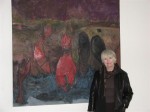A Noir, B Noir
The Noir Style
The Overlook Press
1999
For starters, there are 172 duo-tone photographs of noir’s great moments in this book. In fact, the cover of Alain Silver and James Ursini’s 1999 tome, The Noir Style, will set your hair ablaze. There stands, flame-tressed Rita Hayworth wearing a strapless column of shimmering red satin. Smoke rises from the cigarette in her right hand, and from her pursed lips, a cloud of it hovers over her famously tousled mane. A dangerous broad if ever there was one. And, you can put the blame on Mame, boys.
If you are a fan of a noir, this is it. The opening shot delves into the possible underpinnings of “black film:” German Expressionism and Europeans who settled in Hollywood, the dismal post-World War II populace and, if you want to blame it on improved film stocks and production equipment, go ahead. Few film buffs agree on the roots of film noir (either A or B grade), but the book offers thoughtful possibilities, such as Paul Muni, looming in the 1930s Scarface. His presence, washed in shadows and light from window frames and curtains, are lit of course with a source light.
The authors define this period of gangster and horror films as pre-noir, then go forward to talk about such fabulous flicks as Double Indemnity (1944), which is one of my favorites. On page 29, there is a superb image of Fred MacMurray and Barbara Stanwyck standing shoulder-to-shoulder in a supermarket. She is in big dark glasses, and he, her wayward lover, looks ever-so-skeptical as they tweak the plans for offing her husband.
The book progresses to the era of neo-noir, but I don’t buy neo-noir. Quentin T’s Pulp Fiction (1994), is an example, and yes, it has the flashbacks and other early noir elements, but it’s a film unto itself. So, why tag it as film noir? Other neo-noirs are Fargo (1996) and L.A. Confidential (1997). I do not understand the Fargo connection. Violence? Yes. Flashbacks? Yes. But it is more satire than genuine noir, though, I guess it could be argued that early film noir was satirizing earlier crime films.
Noir — the landscape of rain-lashed streets, cheap blondes who breathe heavy and lug around chunky jewelry and nasty men who do them wrong. Noir is the place where fear reigns and shadows slither. Hopeless noir. Down-at-the-heels noir. Noir where The Mob lives with dames and guys sucked into the brackish swamp of deadly possibilities. Here lies John Garfield, Richard Conte, Shelley Winters, Joan Crawford and other greats who died trying, and through the magic of film, still do. Burt Lancaster as Steve Thompson in Criss Cross (1949), filmed through an array of bars, pulleys, counterweights, slings and shadows. A hunk of meat trapped like a rat and only death will spring the trap. Was there ever a more sensational scene? Of course. There are many such moments in film noir. The best of which are carefully crafted. Bogart. Lupino. Orson Welles. Citizen Kane. The leering lips of Victor Mature.
Da Capo Press
2000
Beneath all of the great “A” noir is another rung on the ladder … a lower rung often ignored known as “B” noir in my library of cheesy paperbacks. A good read in this genre is Arthur Lyon’s Death on the Cheap: The Lost B Movies of Film Noir! (Da Capo Press, 2000).
Here’s what Robert Mitchum said about film noir in his day: “Hell, we didn’t know what film noir was in those days. We were just making movies. Cary Grant and all the big stars (at RKO) got all the lights. We lit our set with cigarette butts.” The literary origins of film noir are said by many film critics to have burbled up from the pages of tough-guy fiction that began in the early 1920s.
There’s humor in these pages. Jail Bait, a 1954 film produced and directed by Ed Wood, winner of the coveted “Golden Turkey Award for Worst Director of All Time,” allowed these sappy lines in Jail Bait:
Plastic surgeon Rawlinson to his daughter: “Plastic surgery seems to be at times to me very, very, complicated.”
Oh yeah. In 1948’s Money Madness, Hugh Beaumont (later to play Ward Cleaver in “Leave it to Beaver”), emerged as a “cunning-but-whacko killer.” Early in his career, Lee Marvin was a short-order cook in Shack Out on 101 (1955).
The year was 1955, when Marvin could still be had for cheap.
Here’s my line to Lee: Listen doll face. Eggs easy over. Got that doll? Splatter the grease, and I’ll slit your throat.
And, oh yeah, doll. For more on noir, go to Wikipedia/film noir. The site’s a gas.






















